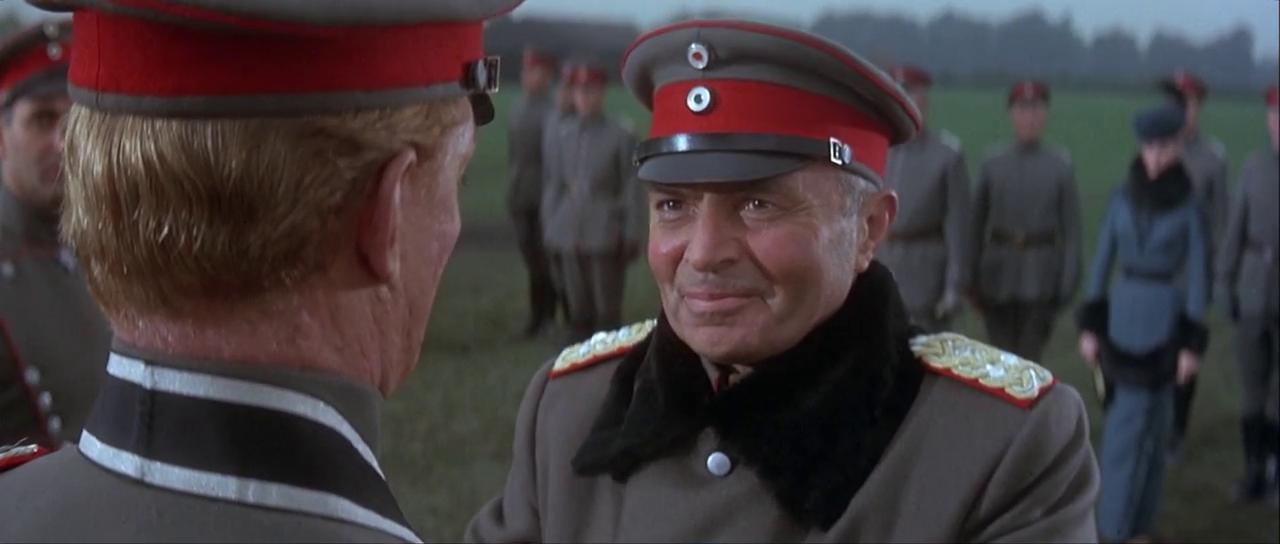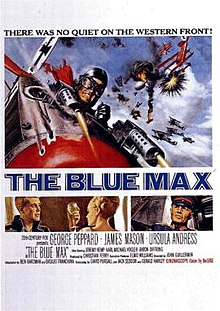“The Blue Max” recently won my Best Dogfighting Movie
tournament. Now it’s time to see how it
holds up as a war movie.
Considered one of the definitive WWI air combat
films, “The Blue Max” was directed by John Guillerman (“The Bridge at
Remagen”). It is based on the novel by
Jack Hunter. The title is a reference to
the German medal officially called “Le Pour le Merite”. The movie had a big budget and an
international cast. It was a moderate
success at the box office and got mixed reviews.
The movie begins on the Western Front in 1916. Corporal Bruno Stachel (George Peppard) is an infantryman in
no man’s land. He witnesses a dogfight
from a shell crater and dreams. While
the credits roll with a dogfight as a back drop, two years pass and Stachel
becomes a trained pilot. He is sent as a
replacement to a Staffel where it is revealed that he is the only commoner
amongst the noble German knights of the air.
His first mission is against an observation balloon. He is flying an obsolete Pfalz D.III They get bounced and he manages to shoot down
a British S.E. 5 in an exciting treetop chase.
When he returns to base, Stachel is obsessed with confirming his kill
and not at all concerned with the loss of his wing mate. His search during a rain storm at night
convinces his squadron mates that he cares only about getting the twenty
victories necessary to win the Blue Max.
This perception is cemented when Stachel attempts to bring a British
reconnaissance plane back to his air field, but is forced to shoot it down at
the last moment. It comes off as him
making sure he gets a confirmed kill this time.
His squadron commander Heidermann (Karl Voger) is incensed with this
violation of the rules of chivalry and is determined to get rid of this son of
a hotel keeper.
Stachel’s rival in the squadron is an ace named
Klugermann (Jeremy Kemp). Klugermann is
the nephew of General Klugerman (James Mason) and is having an affair with the general’s
trophy wife Kaeti (Ursula Andress). The
rivalry in the sky becomes a rivalry between the sheets. Who do you think she will pick – Peppard or
Kemp? As Stachel’s total mounts, General
Cuckold sees him as a people’s hero that can be used for propaganda purposes. This puts him at odds with the moralistic
Heidermann who wants to can Stachel.
Heidermann is pushing for a court-martial after Stachel falsely claims
two victories scored by another pilot. Confronted
with the possible tainting of his golden boy, Gen. Klugermann needs to find a
way to convert the hero into a martyr.
 |
| "Willi, I want to make it clear that this medal is not for sleeping with my wife!" |
“The Blue Max” advances three themes that probably
would have perplexed the generation that lived through the Great War. First, there was a rigid class structure in
the German Air Service. No matter how talented
and successful Stachel became, he would never be accepted by the snooty
aristocrats that were his squadron mates.
By having Stachel come up from the infantry, the movie is connecting the
ground war with the lower classes and the air war with the upper classes. An underappreciated moment in the movie comes
when Stachel is scolded for not celebrating that day's victories and
ignoring their losses. He responds: “Perhaps it’s force of habit. In the trenches, we couldn’t even bury the
dead; there were too many of them…. I’ve never had the time…to discuss them
over a glass of champagne.” Not an
inappropriate analogy. Second, Gen.
Klugermann represents the military’s attempts to manipulate the media. “Truth is the first casualty in war” was not
said about WWI so the movie is backdating that idea. Third, the movie has a theme of the evils of
the military industrial complex. This
may be a bit anachronistic, but Gen. Klugermann being in bed with Anthony
Fokker is not a stretch. WWI was the
first industrialized war and thus must have been the first war where
industrialists and the military had a symbiotic relationship. It was not as developed at this stage as the
movie implies, though. The movie reflects
a 1960s sensibility on these themes.
Speaking of which, the Kaeti character would be more at home in that
decade.
The movie reflects its big budget. The interiors are opulent. Not surprising for a WWI combat movie because
the pilots are of course billeted in a chateau.
A lot of the budget went into the small air force of replica air craft
the movie employs. We see Pfalz D.IIIs,
Fokker D.VIIs, and Fokker Dr. I triplanes.
The cast of planes is in some ways more impressive than the cast of
actors. Guillermin matched the machines
up with a cadre of outstanding stunt pilots. One of those pilots, Derek Piggott, did the
famous flight under the bridge spans more than twenty times. The dogfighting is the most memorable thing
about the movie. There is nineteen
minutes of it to balance the soap opera aspects of the film. There is a “Hell’s Angels” style melee that
shows how modern cinematography had made air combat better. And then CGI came along, so the pendulum has
swung back. The movie has outstanding
sound effects which is an underrated aspect of air combat films. Similarly, the score by Jerry Goldsmith is
superb. It soars with the planes. Typical of a WWI air epic, the movie insists
on getting down and dirty in the trenches.
There is an extended strafing scene and a large-scale trench battle that
is marred by having the British soldiers come out of their trenches to meet the
Germans in no man’s land! This was done
to get the Tommies out in the open so the German fighters could drop bombs they
did not have. Talk about insulting your
audience’s intelligence.
“The Blue Max” is refreshingly devoid of clichés. It does have the granddaddy of the dogfighting tropes: the main character is obsessed with glory.The acting is fine.
Peppard has taken some criticism, but he does a good job in a difficult
role. (Critics should have been more
impressed with the fact that he learned how to fly so he could be in more
shots.) In 1966, the anti-hero had not
quite developed into the icon we have today so he had to walk a fine line
between jerk and misunderstood jerk.
Amazingly, Jeremy Kemp steals the acting honors. His Willi is suavely cynical. And he’s sleeping with his step-aunt! The best dialogue is the exchanges between
Bruno and Willi. James Mason is perfect
as the Machiavellian Gen. Klugermann and Vogler is great as the righteous
Heidermann. (By the way, they both
played Erwin Rommel in movies.) The weak
link is Andress, of course. She is not
there for her acting ability obviously. On
the plus side, there is some chemistry between her and Peppard. On the minus side, she keeps her clothes on,
mostly.
 |
| Damn you, towel! |
In conclusion, although it is the best movie about dogfighting, it is not a great movie and may not make my 100 Best War Movies list. In my opinion, there is still an opening for an outstanding example of this subgenre. Dogfighting movies are still waiting for their "Das Boot".
GRADE
= B
the trailer
a dogfight

I agree. It is a good movie but not great. It was interesting to see the German perspective and the rigid class structure but the story is more about a middle-class man failing to win true acceptance than about the war itself. The dogfighting scenes are excellent but not enough.
ReplyDelete